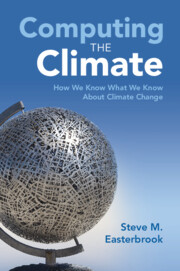Book contents
- Computing the Climate
- Epigraph
- Computing the Climate
- Copyright page
- Contents
- Preface
- Acknowledgements
- 1 Introduction
- 2 The World’s First Climate Model
- 3 The Forecast Factory
- 4 Taming Chaos
- 5 The Heart of the Machine
- 6 The Well-Equipped Physics Lab
- 7 Plug and Play
- 8 Sound Science
- 9 Choosing a Future
- References
- Index
5 - The Heart of the Machine
Published online by Cambridge University Press: 10 August 2023
- Computing the Climate
- Epigraph
- Computing the Climate
- Copyright page
- Contents
- Preface
- Acknowledgements
- 1 Introduction
- 2 The World’s First Climate Model
- 3 The Forecast Factory
- 4 Taming Chaos
- 5 The Heart of the Machine
- 6 The Well-Equipped Physics Lab
- 7 Plug and Play
- 8 Sound Science
- 9 Choosing a Future
- References
- Index
Summary
Today’s climate models trace their lineage to the global circulation models of the 1950s. The core equations are the same, but the algorithms that implement them have evolved, and scientists have taken advantage of each new generation of faster computers to improve their models. The models I’ve studied often weigh in at more than a million lines of code, contributed over many years by hundreds of scientists. And they keep evolving; every climate model is a work in progress. Even the beating heart of a climate model – its “dynamical core” – gets replaced every once in a while. In this chapter, we’ll examine one model in particular, the UK Met Office’s Unified Model, and explore its dynamical core and the design decisions that shaped it.
- Type
- Chapter
- Information
- Computing the ClimateHow We Know What We Know About Climate Change, pp. 121 - 157Publisher: Cambridge University PressPrint publication year: 2023

